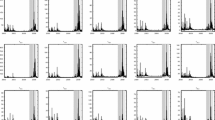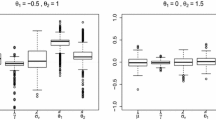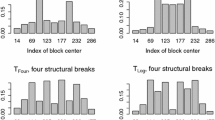Abstract
A data-driven approach for modeling volatility dynamics and co-movements in financial markets is introduced. Special emphasis is given to multivariate conditionally heteroscedastic factor models in which the volatilities of the latent factors depend on their past values, and the parameters are driven by regime switching in a latent state variable. We propose an innovative indirect estimation method based on the generalized EM algorithm principle combined with a structured variational approach that can handle models with large cross-sectional dimensions. Extensive Monte Carlo simulations and preliminary experiments with financial data show promising results.
Similar content being viewed by others
References
Akaike, H. (1974) A new look at the statististical identification model. IEEE Transactions on Automatic Control 19, 716–723
Anderson, B.O., Moore, J.B. (1979) Optimal Filtering. Prentice Hall, Englewood Cliffs, NJ
Barber, D., Wiegerinck, W. (1999) Tractable variational structures for approximating graphical models. In: Kaerns, M.S., Solla, S.A., Cohn, D.A. (eds.) Advances in neural information processing systems. 183–189, MIT Press, Cambridge, MA
Bera, A.K., Jarque, C.M. (1982) Model specification tests: A simultaneous approach. Journal of Econometrics 20, 59–82
Campbell, J.Y., Lettau, M., Malkiel, B.G., Xu, Y. (2001) Have individual stocks become more volatile? An empirical exploration of idiosyncratic risk. Journal of Finance 56, 1–43
Demos, A., Sentana, E. (1998) An EM algorithm for conditionally heteroscedastic factor models. Journal of Business & Economic Statistics 16, 357–361
Dempster, A., Laird, N., Rubin, D. (1977) Maximum Likelihood from incomplete data via the EM algorithm. Journal of Royal Statistical Society Series B 39, 1–38
Diebold, F., Nerlove, M. (1988) The dynamics of exchange rate volatility: A multivariate latent factor ARCH model. Journal of Applied Econometrics 4, 1–22
El-Hay, T., Friedman, N. (2001) Incorporating expressive graphical models in variational approximations: Chain-graphs and hidden variables. Breese, J.S., Koller, D. (eds.) Proc. Seventeenth Conf. on Uncertainty in Artificial Intelligence (UAI). University of Washington, Seattle 136–143
Engle, R., Ng, V.K., Rothschild, M. (1990) Asset pricing with a Factor-ARCH covariance structure: Empirical estimates for treasury bills. Journal of Econometrics 45, 213–237
Engle, R., Ng, V.K., Rothschild, M. (1992) A multi-dynamic factor model for stock returns. Journal of Econometrics 52, 245–266
Engle, R., Susmel, R. (1993) Common volatility in international equity markets. Journal of Business & Economic Statistics 11, 369–380
French, K., Schwert, G., Stambaugh, R. (1987) Expected stock returns and volatility. Journal of Financial Economics 19, 3–30
Ghahramani, Z., Jordan, M.I. (1997) Factorial Hidden Markov Models. Machine Learning 29, 245–274
Geweke, J.F., Zhou, G. (1996) Measuring the pricing error of the arbitrage pricing theory. The Review of Financial Studies 9, 557–587
Gupta, A.K. (1952) Estimation of the mean and standard deviation of a normal population from a censored sample. Biometrika 39, 260–273
Harvey, A., Ruiz, E., Sentana, E. (1992) Unobserved component time series models with ARCH disturbances. Journal of Econometrics 52, 129–157
Jaakkola, T.S., Jordan, M.I. (1996) Computing upper and lower bounds on likelihoods in intractable networks. Horvitz, E., Jensen, F.V. (eds.) Proceedings of the Twelth Annual Conference on Uncertainty in Artificial Intelligence. Reed College, Portland 340–348
Jaakkola, T.S., Jordan, M.I. (1998) Improving the mean field approximation via the use of mixture distributions. Jordan, M.I. (ed.) Learning in graphical models. Kluwer Academic Publishers, Norwell, MA
Jones, C.S. (2001) Extracting factors from heteroskedastic asset returns. Journal of Financial Economics 62, 293–325
Jordan, M.I., Ghahramani, Z., Jaakkola, T.S., Saul, L.K. (1998) An introduction to variational methods for graphical models. Machine Learning 37, 183–233
Juang, B.H., Rabiner, L.R. (1985) A probabilistic distance measure for hidden Markov models. AT&T Technical Journal 64, 391–408
King, M., Sentana, E., Wadhwani, S. (1994) Volatility and links between national stock markets. Econometrica 62, 901–933
Lawrence, N.D., Bishop, C.M., Jordan, M.I. (1998) Mixture representations for inference and learning in Boltzmann machines. In: Kaufmann, M. (ed.) Proceedings of the 14th Annual Conference on Uncertainty in Artificial Intelligence (UAI), pp. 320–332. San Francisco, CA
Lin, W. (1992) Alternative estimators for factor GARCH models: a Monte Carlo comparaison. Journal of Applied Econometrics 7, 259–279
Ljung, G., Box, G. (1978) On a measure of lack of fit in time series models. Biometrika 67, 297–303
Saidane, M., Lavergne, C. (2006a) A generalized pseudo-Bayesian EM algorithm for switching dynamic factor analysis. International Journal of Computer Science and Network Security 6, 30–37
Saidane, M., Lavergne, C. (2006b) On factorial HMMs for time series in finance. The Kyoto Economic Review 75, 63–90
Saidane, M., Lavergne, C. (2006c) Learning and inference in mixed-state conditionally heteroscedastic factor models using viterbi approximation – lecture notes in Computer Science. LNCS 3994, Part IV, 372–379. Springer-Verlag, Berlin Heidelberg
Schwarz, G. (1978) Estimating the dimension of a model. Annals of Statistics 6, 461–464
Schwert, G.W. (1989) Why does stock market volatility change over time? Journal of Finance 44, 1115–1153
Schwert, G.W., Seguin, P.J. (1990) Heteroskedasticity in stock returns. Journal of Finance 45, 1129–1155
Sentana, E. (1995) Quadratic ARCH models. Review of Economic Studies 62, 639–661
Shapiro, S.S., Francia, R.S. (1972) An approximate analysis of variance test for normality. Journal of the American Statistical Association 67, 215–216
Sharpe, W.F. (1963) A simplified model for portfolio analysis. Management Science 9, 277–293
Stephens, M.A. (1975) Asymptotic properties for covariance matrices of order statistics. Biometrika 62, 23–28
Wainwright, M., Jaakkola, T., Willsky, A. (2002) A new class of upper bounds on the log partition function. IEEE Transactions on Information Theory 51, 2313–2335
Author information
Authors and Affiliations
Corresponding author
Rights and permissions
About this article
Cite this article
Saidane, M., Lavergne, C. A structured variational learning approach for switching latent factor models . AStA 91, 245–268 (2007). https://doi.org/10.1007/s10182-007-0031-4
Received:
Accepted:
Published:
Issue Date:
DOI: https://doi.org/10.1007/s10182-007-0031-4




